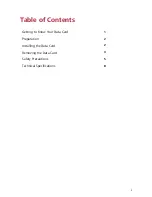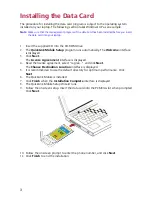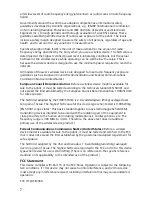
7
emits low levels of radio frequency energy (also known as radio waves or radio frequency
fields).
Governments around the world have adopted comprehensive international safety
guidelines, developed by scientific organizations, e.g. ICNIRP (International Commission
on Non-Ionizing Radiation Protection) and IEEE (Institute of Electrical and Electronics
Engineers Inc.), through periodic and thorough evaluation of scientific studies. These
guidelines establish permitted levels of radio wave exposure for the public. The levels
include a safety margin designed to assure the safety of all persons, regardless of age and
health, and to account for any variations in measurements.
Specific Absorption Rate (SAR) is the unit of measurement for the amount of radio
frequency energy absorbed by the body when you use a wireless device. The SAR value is
determined at the highest certified power level in laboratory conditions, but the actual
SAR level of the wireless device while operating can be well below the value. This is
because the wireless device is designed to use the minimum power required to reach the
network.
All models of Huawei's wireless device are designed to meet radio frequency exposure
guidelines such as European Council Recommendation and Federal Communications
Commission Notice (United States).
European Council Recommendation:
Before a wireless device model is available for
sale to the public, it must be tested according to the technical standard-EN 50361 and
not exceed the limit established by the European Council Recommendation: 1999/519/EC
for safe exposure.
The SAR limit adopted by the 1999/519/EC is 2.0 watts/kilogram (W/kg) averaged over
ten gram of tissue. The highest SAR value for this device type when tested is 0.996 W/kg.
[EN 50361 scope states "This basic standard applies to any electromagnetic field (EM)
transmitting devices intended to be used with the radiating part of the equipment in
close proximity to the human ear including mobile phones, cordless phones, etc. The
frequency range is 300 MHz to 3 GHz. Therefore, the above text does not address
primary use of the wireless device product.]
Federal Communications Commission Notice (United States):
Before a wireless
device model is available for sale to the public, it must be tested and certified to the FCC
that it does not exceed the limit established by the government-adopted requirement for
safe exposure.
The SAR limit adopted by the USA and Canada is 1.6 watts/kilogram (W/kg) averaged
over one gram of tissue. The highest SAR value reported to the FCC and IC for this device
type when tested for use is 0.633 W/kg. [There is no reference to the specific reference
standard or its applicability to the intended use of the product.]
FCC Statement
This device complies with Part 15 of the FCC Rules. Operation is subject to the following
two conditions: (1) this device may not cause harmful interference, and (2) this device
must accept any interference received, including interference that may cause undesired
operation.
FCC ID: QISEC360




























